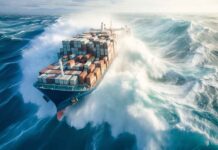Months have passed since the collision between the oil tanker MT Sanchi and the cargo ship MV CF Crystal in China jurisdiction waters. At present, the plan for cleaning up the oil remaining on board the tanker has yet to be finalized, the pollution clean up work has not yet finished and the reason for the collision is still under investigation. The PRC Ministry of Transport said this collision is the first collision and fire involving a tanker carrying natural-gas condensate in shipping history. The accident resulted in the sinking of the MT Sanchi, and the spillage of the natural-gas condensate and fuel oil carried by the tanker.

VICTORIA WEI
万商天勤律师事务所合伙人
Partner
V&T Law Firm
As there is a possibility that the natural-gas condensate will be determined to be a “non-persistent” oil, pursuant to China’s legal system for oil pollution damage liability, the damages that the owner of the MT Sanchi will be required to bear for the oil pollution damage will become complicated.
The Ministry of Transport says that at the time of the collision the MT Sanchi was carrying 113,000 tons of natural-gas condensate, which exploded and spilled. The fuel oil on the tanker also spilled. According to preliminary monitoring results, the spill has had a certain impact on the ecological environment of the territorial waters where the accident occurred. At the time that it sank, the MT Sanchi still had incompletely burnt natural-gas condensate and a certain quantity of fuel oil on board which will have a major damage impact on the marine environment. The owner of the MT Sanchi will face such oil spill damage claims as pollution clean-up expenses, marine natural resource and ecological environment damage, and residual oil removal expenses.
Liability limits. Pursuant to China’s legal system for vessel oil pollution damage liability, the liability for vessel oil pollution damage is divided into the system for oil pollution damage liability arising from persistent oil (including persistent cargo oil and fuel oil) carried by an oil tanker, and the system for oil pollution damage liability arising from fuel oil carried by other than an oil tanker or non-persistent oil carried by an oil tanker.
The former is governed by the International Convention on Civil Liabi1ity for Oi1 Pollution Damage, 1992 (CLC) while the latter is governed by chapter 11 of the Limitations on Maritime Liability, of the PRC Maritime Law, and the Provisions of the PRC Supreme People’s Court on Several Issues Concerning the Trial of Vessel Oil Pollution Damage Dispute Cases.
The main differences between the two liability systems are that the limitation on damages is different, and whether the vessel owner can assert limitations on the liability for expenses of a pollution clean-up and pollution prevention nature in oil pollution damage claims.
Regarding the expenses arising in order to prevent damage caused by fuel oil carried by other than oil tankers or non-persistent oil carried by oil tankers, including pollution clean-up charges, residual oil removal expenses and pollution prevention expenses, the vessel owner usually cannot claim limitations on liability. If these expenses arise in connection with persistent oil carried by an oil tanker, the tanker owner may claim limitations on liability, unless there is an exception under which it loses such limitations.
If natural-gas condensate is determined not to be a “persistent oil”, then, theoretically, the oil pollution damage caused by the MT Sanchi’s fuel oil, and by the natural-gas condensate, should be treated differently. The limit of liability for damages claimed for the oil pollution damage caused by the fuel oil is determined based on the CLC, whereas the portion of the liability that can be limited by the oil pollution damage caused by the natural-gas condensate is to be compensated for based on the limit on maritime liability specified in the Maritime Law.
Pursuant to the Several Provisions of the Supreme People’s Court on the Trial of Dispute Cases Relating to Limitations on Maritime Liability, the Provisions for Compensation for Vessel Oil Pollution Damage and the judgment of the Supreme People’s Court in the “Zeus” oil tanker case between Shinhan Investment and the Jiangmen Maritime Bureau, the owner of the MT Sanchi would be required to compensate in full for such expenses as: cleaning up the pollution caused by the natural-gas condensate; cleaning up the natural-gas condensate remaining on the sunken vessel; and for preventing pollution by the natural-gas condensate in the salvage expenses, and would not be able to claim limitations on liability.
Having a gross tonnage of 85,462 tons, the MT Sanchi’s maritime liability limit is about RMB140 million (US$22.1 million); and its CLC oil pollution damage liability limit is about RMB337 million. As the International Convention on the Establishment of an International Fund for Compensation for Oi1 Pollution Damage, 1992, and the Administrative Measures for the Levy and Use of the Vessel Oil Pollution Damage Fund are not applicable in this case, MT Sanchi’s owner’s liability would be limited to RMB337 million.
Assuming that natural-gas condensate is a “non-persistent oil”, then, theoretically, such expenses for, and losses relating to, pollution clean-up, removal of residual oil, pollution prevention and maritime natural resource and ecological environment damage would be differentiated between those arising from the natural-gas condensate and those from the fuel oil.
In actual practice, can these expenses and damages be differentiated in a reasonable and evidence-based manner? The author contends that it needs to be determined based on the opinions of experts and technicians.
Even if they can be differentiated, consideration also needs to be given to whether the evidence that backs up the various expenses or losses can support this kind of differentiation, something that will only become clear with how the accident is ultimately handled, and based on the opinions of the experts and technicians.
Assuming that such a reasonable and evidence-based differentiation is not possible, the author contends that, under the framework of China’s current legal system for oil pollution damage liability, the unified application of either legal system for oil pollution compensation is inappropriate, and consideration could be given to an equal allocation of the oil pollution damage that cannot be reasonably differentiated. This way of proceeding would be fair for both the owner of the MT Sanchi and for the relevant stakeholders affected and harmed by the oil pollution.
The MT Sanchi incident will give rise to numerous legal issues concerning the liability for oil pollution damage, and if the issue of liability for the accident is ultimately resolved by way of a court judgment, this will again test China’s legal system for oil pollution damage liability, and the result produced by the court will also have a reference effect on the resolution of similar cases in future.
Victoria Wei is a partner at V&T Law Firm. She can be contacted on +86 21 5081 9193 or by email at victoria.wei@vtlaw.cn






















